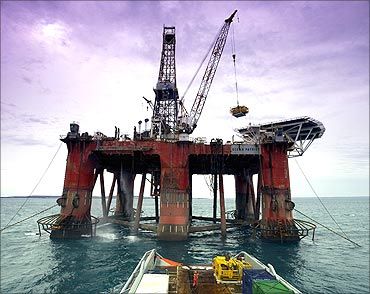 The task of Union Finance Minister Arun Jaitley to keep inflation under check, even when the country reeled under severe drought for two years in a row, and reduce the current account deficit, was made easier by low crude oil prices.
The task of Union Finance Minister Arun Jaitley to keep inflation under check, even when the country reeled under severe drought for two years in a row, and reduce the current account deficit, was made easier by low crude oil prices.
The unending controversy over the advisability of extinguishing high-denomination currency bills has distracted the nation from the way a likely rise in crude oil prices in the new year and 2018 could derail many of New Delhi’s macroeconomic calculations.
Except for a brief period at the start of the National Democratic Alliance rule, the task of Union Finance Minister Arun Jaitley to keep inflation under check, even when the country reeled under severe drought for two years in a row, and reduce the current account deficit, was made easier by low crude oil prices.
In a prudent move, instead of passing on to users in full the low crude oil prices, New Delhi in phases raised the specific excise duty on diesel and petrol to shore up its coffers. But as the slide in crude oil prices, starting in mid-2014 from well over $100 a barrel to $26.05 in February, proved a blessing for energy-intensive India, there was also a flip side to it.
Motorists and agriculturists, because of the low price, lifted India’s crude oil use by 11.08 per cent to 183.5 million tonne (mt) in 2015-16. This led to the country raising crude imports by 13 mt to 202 mt last year, while indigenous crude production stagnated at around 37 mt, thanks to investment shyness in new substantial sources of crude oil. As a result, the country remains nearly 80 per cent import-dependent for crude oil.
Global oversupply of crude oil, resulting from the abandonment of production ceilings by the Organisation of the Petroleum Exporting Countries and cartel leader Saudi Arabia’s decision to go on pumping oil at optimum level to hold on to its market share, kept energy prices highly affordable for all importing nations.
It is because of this that India’s crude oil import bill was down to $64 billion in 2015-16 from $112 billion in the previous year, though the import volume was up.
But all importing nations, including India, received a jolt when in November OPEC members reached their first consensus since 2008 to cut oil production by 1.2 million barrels per day (bpd) to 32.5 million bpd from January. Then, in December, non-OPEC members, notably Russia, agreed to shave their output by 558,000 bpd.
The non-OPEC cut, though short of the targeted 600,000 bpd, is going to be the largest-ever contribution to production discipline by the industry.
Expectedly, the benchmark Brent crude was up more than 4 per cent to $56.64 a barrel, the highest since July 2015, immediately on the announcement of the non-OPEC decision.
Fuelling ambitions
No wonder, then, Vedanta chairman Anil Agarwal is keener than ever to put big money into crude oil, reading all the positive price estimates by analysts in the two production-cut agreements. He sees in India’s hydrocarbon sector, including prospecting for shale oil and gas, many “exciting opportunities to explore.”
Agarwal has plans to invest at least Rs 30,000 crore in exploration and production by Cairn India in the next three years. The investment will step up Cairn’s oil production from 250,000 bpd to 350,000 bpd. In the process, the company’s share in the country’s crude production will jump from 30 per cent to 50 per cent.
The scope for oil exploration in India is huge as “we are doing it in just about 10 per cent of our basins against 90 per cent in many countries,” says Agarwal.
This apart, his ambition to produce shale oil and gas on a large scale in Rajasthan stands to get a leg up from the 29 per cent price gain forecast for oil in 2017 on last year’s average based on the median of 24 analyst estimates compiled by Bloomberg.
Ahead of Vedanta’s takeover of Cairn India, a former chief executive of the company had said: “At Rajasthan, we see the presence of tighter gas and oil resources that lend themselves well to shale gas exploration.” Agarwal has promised not to take much time to venture into shale once New Delhi is ready with the policy for the sector.
Perhaps the most important innovation of the century, the technology, a combination of horizontal drilling and hydraulic fracturing that allows extraction of oil and gas from otherwise unyielding shale rocks, heralded the shale revolution in 2008-09 first in the US and then in Europe.
The peaks and troughs
The US oil industry had peaked in 1970 and then went through many years of unchecked decline till 2009 when the shale breakthrough gave it the desired energy security.
Moreover, benefiting from the shale boom, which was very largely aided by high crude oil prices, the US sprinted into a position to nearly match the production of Saudi Arabia and Russia. These three producers extract a third of the world’s crude oil.
Longstanding differences with Iran apart, which had to be set aside to promote production discipline, what led Riyadh to pump oil without restriction was to force high-cost producers elsewhere, particularly the upstart shale groups in the US, to shut operation.
Many small shale oil producers were brought to their knees by subsequent price collapse and the US rig count fell by more than 70 per cent from when oil was well over $100 a barrel. Interestingly, as industry observers point out, none of the US big and mid-sized shale oil producers pumping more than 100,000 bpd had collapsed due to the price fall.
The new mantra in the industry is to be “fit at $50 a barrel.” With Brent trading at close to $57 a barrel and the US benchmark West Texas Intermediate at around $54, and the likelihood of prices firming up a little more in case OPEC members and non-OPEC producers don’t “cheat”, the US shale output could get a production boost of 500,000 bpd to 4.5 million bpd.
Crude oil producers of all sizes went through the rigours of cost-cutting since mid-2014 to be able to meet dividend expectations of shareholders and investment requirements. They all are still at the exercise. You could see oil gush out of US fields, including shale wells, if oil remains around $60 a barrel.
Won’t that lead Saudi Arabia and others to rethink their policy?
Image: An oil rig. Photograph: Reuters.












 © 2025
© 2025